Mandy Barker on
Art Photography to Raise Awareness on Plastic Pollution
and the effects Plastic Debris has on Our Oceans, Marine Life and Our Lives
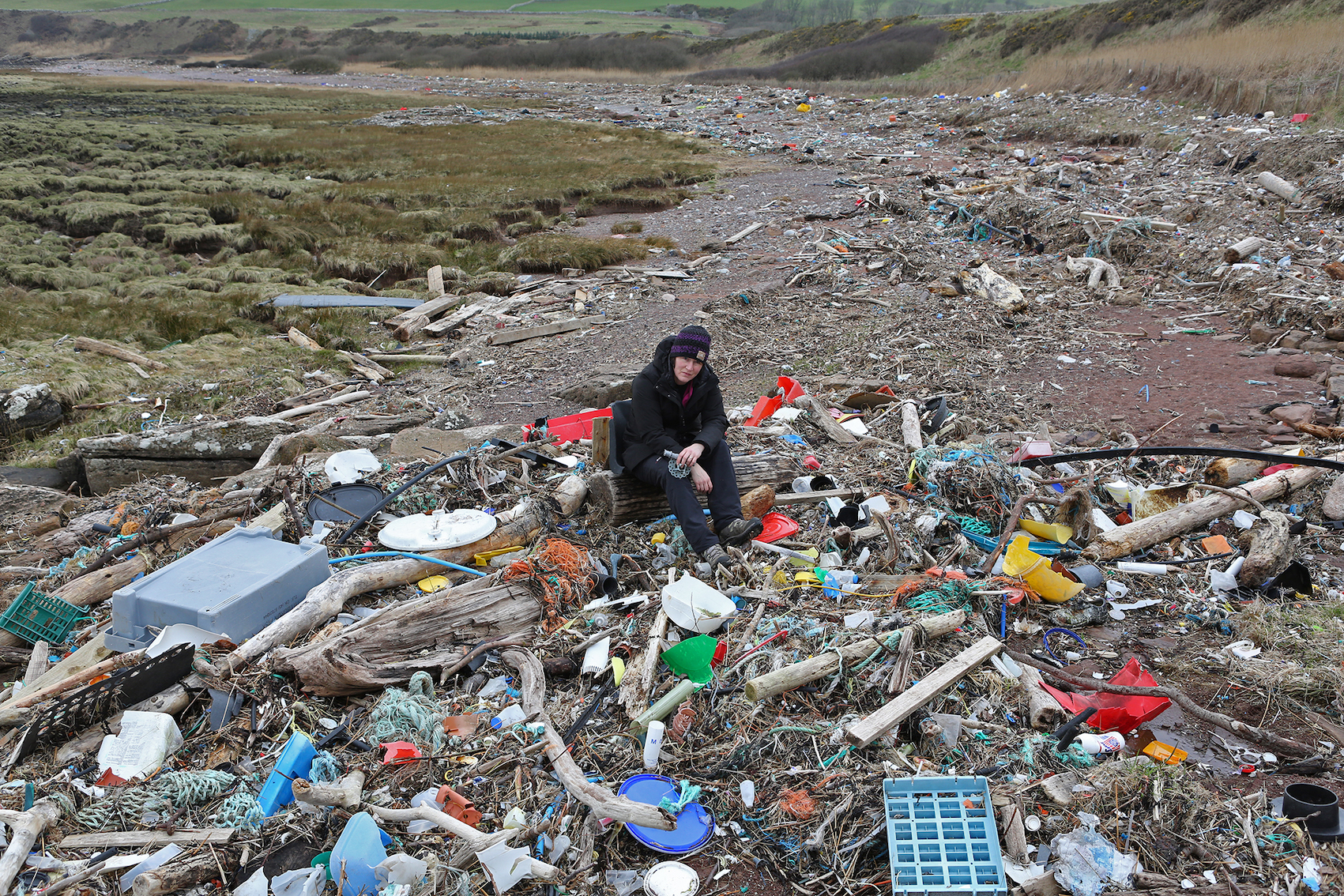
Mandy Barker , Photograph © Mandy Barker
Mandy Barker's art photography raises awareness on plastic pollution and its effects. Working alongside scientists, Barker travels around the world to capture and highlight the impact plastic debris is having on our oceans, on marine life and on our lives.
Transforming the debris into alluring art and patterns, the artist through photography leads the viewer to discover an underwater world of plastic swirls, of motifs, colours, visual appeal and concrete concerns, with a whirl of information and realisation released on what is happening deep at the bottom of our oceans.
Shedding a light on the plastic objects that will either stay for many years or indefinitely with us on earth unless burnt, Mandy Barker’s activism and dedication projects itself into compelling photography, using art as a voice to relay on the damaging consequences of plastic pollution.
When did you start becoming concerned with marine pollution and photographing plastic debris?
My concern with marine plastic started in 2008. During my childhood I had always enjoyed being by the sea, collecting natural objects such as driftwood and shells. Increasingly over the years I noticed these being replaced by man-made waste, especially plastic. I found household appliances such as fridge freezers, computers, tv’s, etc, on the beach of a local nature reserve and began to wonder how they got there. It was an environmental concern that needed to be shared and this is what initially stimulated my work - to raise awareness of my own experience to a wider audience.
Can you share with us a bit about your work process?
Initially I collect information from reading academic research journals and by attending international conferences. Working directly with scientific experts who are studying the problem first hand, is a key aspect of the research process for me. This inspires my work, whether it is a particular species or area that is affected, or a particular type of plastic or object that is having a detrimental effect on biodiversity. I develop my thought process through sketchbook journals, which enable my ideas to come together. I then collect the marine plastic from beaches and oceans around the world – sometimes from a specific beach and with similar objects or colours depending on the project. I photograph the plastic back in my studio by randomly scattering the pieces on a black background, sometimes creating several layers which are then sandwiched together. The images are intended to be attractive to draw the viewer in to see what the objects are, once the viewer has read the caption, this contradiction alongside the shocking caption hopefully creates the subsequent message of awareness.
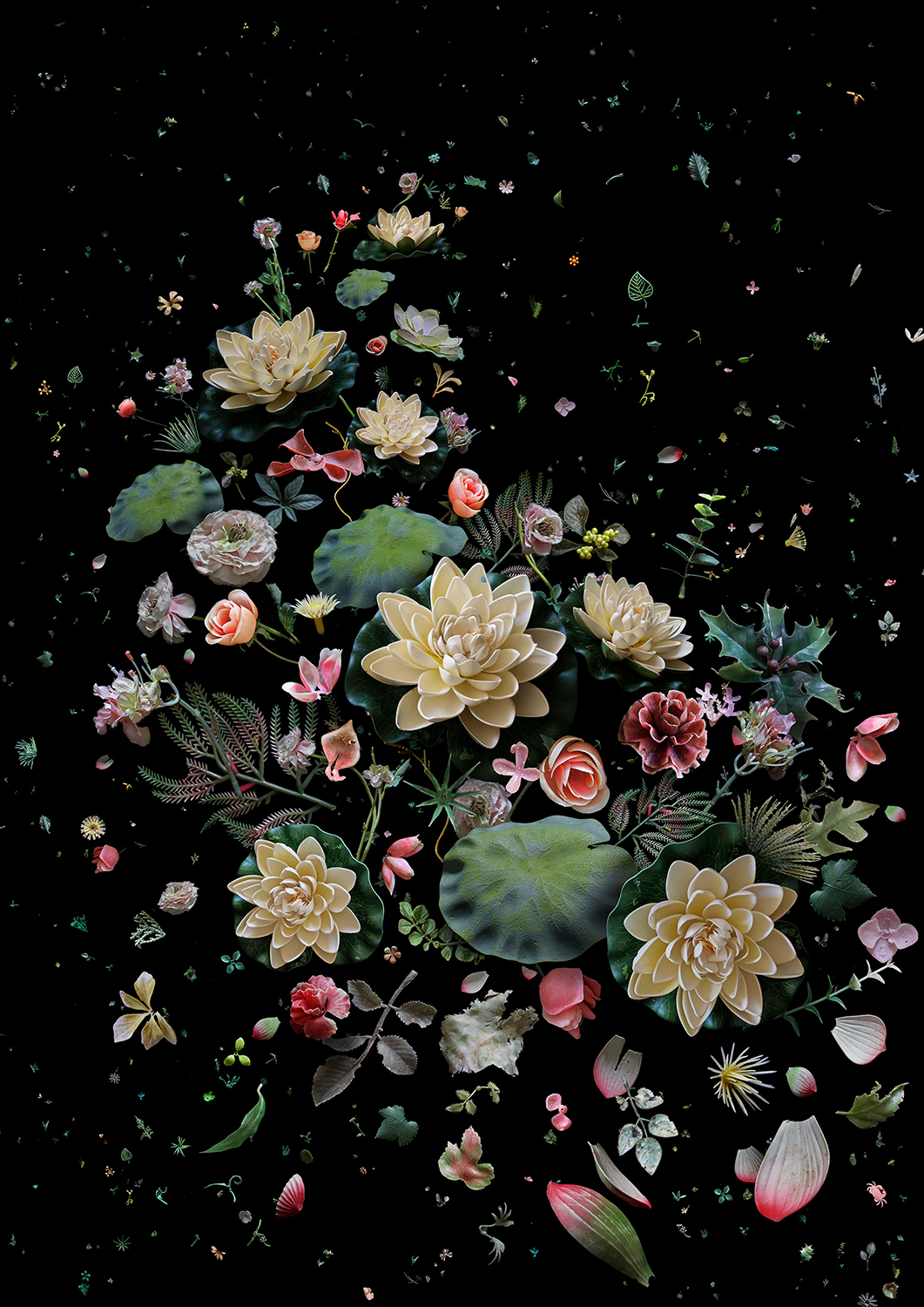
Hong Kong Soup: 1826 - Lotus Garden, 香港湯:1826, Photograph © Mandy Barker
A collection of different species of discarded artificial flowers that would not exist at the same flowering time in nature should not be found in the ocean. The flowers were recovered from various beaches in Hong Kong over the past three years (includes; lotus flowers, leaves & petals, peony, carnation, rose, blossom, holly, ferns, castor & ivy leaves).
Your series ‘Indefinite’ looks at how long it takes for discarded plastic objects to degrade in the sea, you have mentioned that since doing the series, research by polymer scientists have found that all conventional plastics will remain on the planet. in a form too large to be biodegraded.
What are some of the damages that plastics have caused that we should all know about that have affected the marine ecosystem, what can we each do to reduce plastic pollution and do you think more regulations or collective responsibility are needed?
Research has moved on significantly since I first started with the series INDEFINITE and it is shocking to think that unless burnt, all the plastic we have ever created is still with us in some form or another. Marine plastic pollution affects marine wildlife and birds which mistake plastic for food leading to suffocation, and starvation. Rafting plastic that travels across oceans can carry invasive species that can disrupt ecosystems and affect biodiversity on other continents. More concerning are recent studies that show the impact for human health, “The United Nations has warned that chemicals in microplastics are associated with serious health impacts including changes to human genetics, brain development and reproduction”. We already know that plastic is now in our blood and in the placentas of unborn babies, I hope this alone will be enough to make us want to refuse plastic; to reuse what we already have, to act to stop manufacturers increased production, and to find alternatives to the material of plastic at the design stage.

450 Years, Or INDEFINITE, Photograph © Mandy Barker
(Plastic Bottle - 90% of marine rubbish found on coastlines worldwide is related to single-use plastics; bottles, tops, straws, food packaging and general packaging. 111 different species of seabirds are know to ingest plastics, many of which are bottles.)
Each plastic object or its debris has a past life, past utility, and through your creativity you are shaping them into works of art and a vehicle to raise awareness on marine pollution. Have there been objects from across the years that you reflect on more than others?
I represent what I find at a particular location. The shoreline might be covered in microplastics, syringes or plastic bottles, but I always make an accurate representation alongside given research from a particular country or environment. I was recently in America as Beyer Artist in Residence 2023 and during the residency I was in touch with beach cleaners that were finding significant amounts of hazardous medical waste washing up on the West Coast of the US. I always find syringes on most of the beaches I collect from, but I have never found this type or amount of medical waste, which really shocked me. Speaking with scientists there, sadly these items are likely to have come from a Caribbean Island with no infrastructure to manage its own waste.
Do you see these objects becoming a connecting element? Such as with the Penalty series, photographing footballs, where after you did a call out on social media, people from around the world collected footballs they found in the sea or on the shoreline.
I often create images or projects to raise awareness at the time of global events and the FIFA World Cup 2014 was the catalyst for the creation of PENALTY to be able to raise awareness during an international sporting event. The project involved the collaboration with members of the public from around the world after a call via social media for people to collect and post footballs they found in the sea or on the shoreline. In total I received 992 marine debris footballs and the project is still widely shared at each following world cup since. It was also featured on CNN in the US for the programme ‘Connect the World’ which is what I had hoped to do.

PENALTY - The World, Photograph © Mandy Barker
769 marine debris footballs (and pieces of) collected from 41 countries and islands around the world, from 144 different beaches, and by 89 members of the public in just 4 months.
Your work merges art and science, can you tell us about some of the collaborations you have done with scientists and some of your travels to highlight marine pollution, such as when you took part in the Henderson Island Plastic Pollution Expedition and produced three different photographic series.
Science is not subjective as it is factual with no room for aesthetics or emotion, so in that sense the work of an artist and a scientist are opposed in approach, but in some way are seeking to achieve the same outcome. My work visually represents the issue whilst being true to the facts and raises awareness amongst people who perhaps would not get to read such articles or have the opportunity to visit affected areas, like Henderson Island. It was such an honour to be asked to join this expedition that I created 3 different series of work, each to engage a different audience. The SHELF-LIFE series represented the mass accumulation of debris on this UNESCO World Heritage Site, LUNASEA highlighted the amount of fishing buoys washed up on this coral atoll and I also had a working camera specially created from marine plastic debris that I took with me to the island to photograph the plastic problem there.
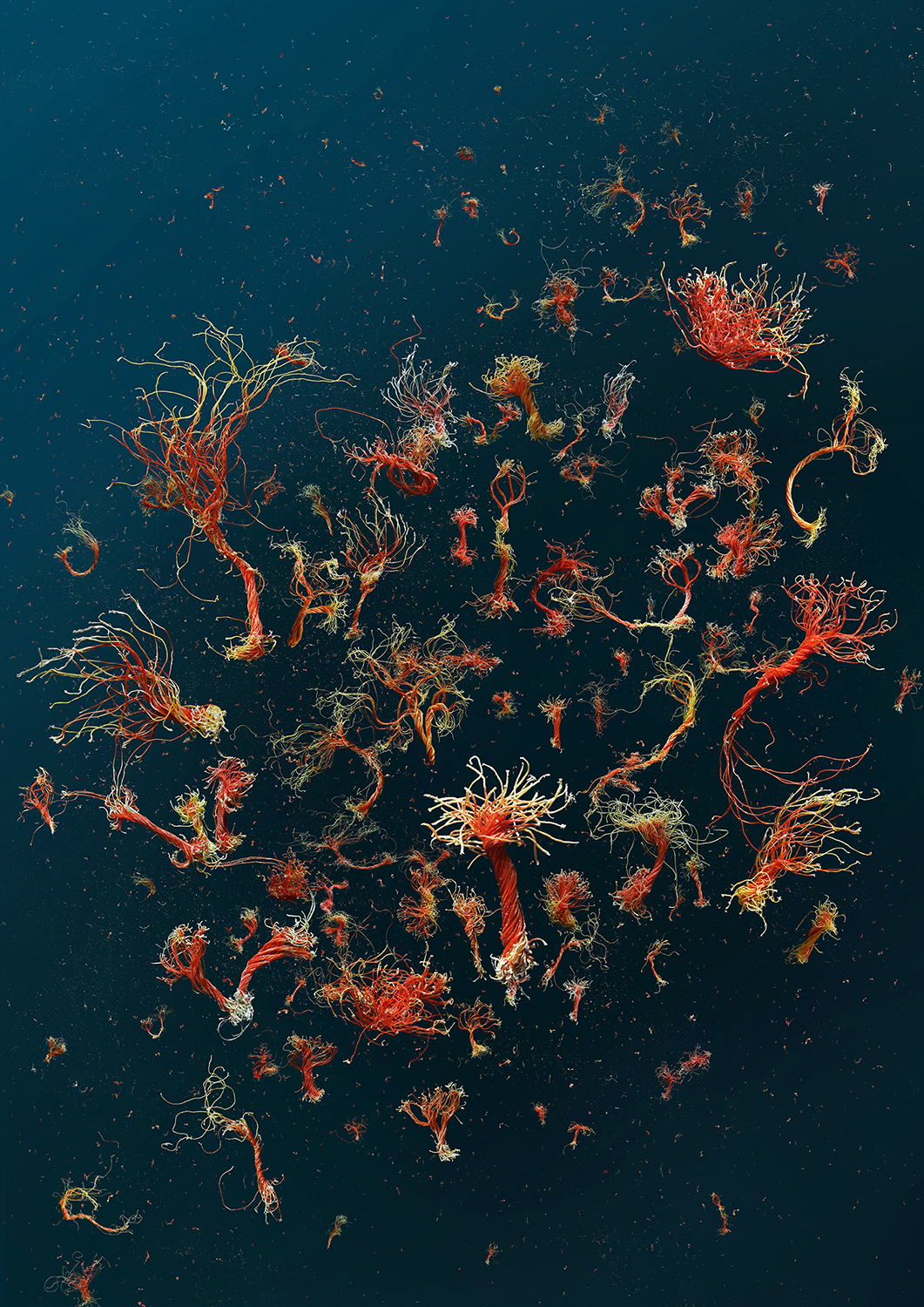
Barcode - 490250 5085680 (Japan), from the series SHELF-LIFE, Photograph © Mandy Barker
3" pieces of fishing net recovered from Henderson Island, June 2019.

Barcode - 50P 300015 (USA), from the series SHELF-LIFE , Photograph © Mandy Barker
Plastic products from more than 25 different countries recovered from Henderson Island, June 2019.
(Includes: 'Optimus Prime' Transformer-McDonalds Happy Meal Toy from 2013, inkjet cartridges, hydrogen peroxide, bleach, oil, & shampoo containers, deodorant, syringes, ice cube tray, toys, fishing gear, lighters, food crates & packaging, household items, shoes & boots, pens, water bottles & caps, ice skating boot, stiletto heel, toilet seat, hairbrush, diving equipment, industrial pipe & filler, chess piece & Dumbo the Flying Elephant from 1961...)
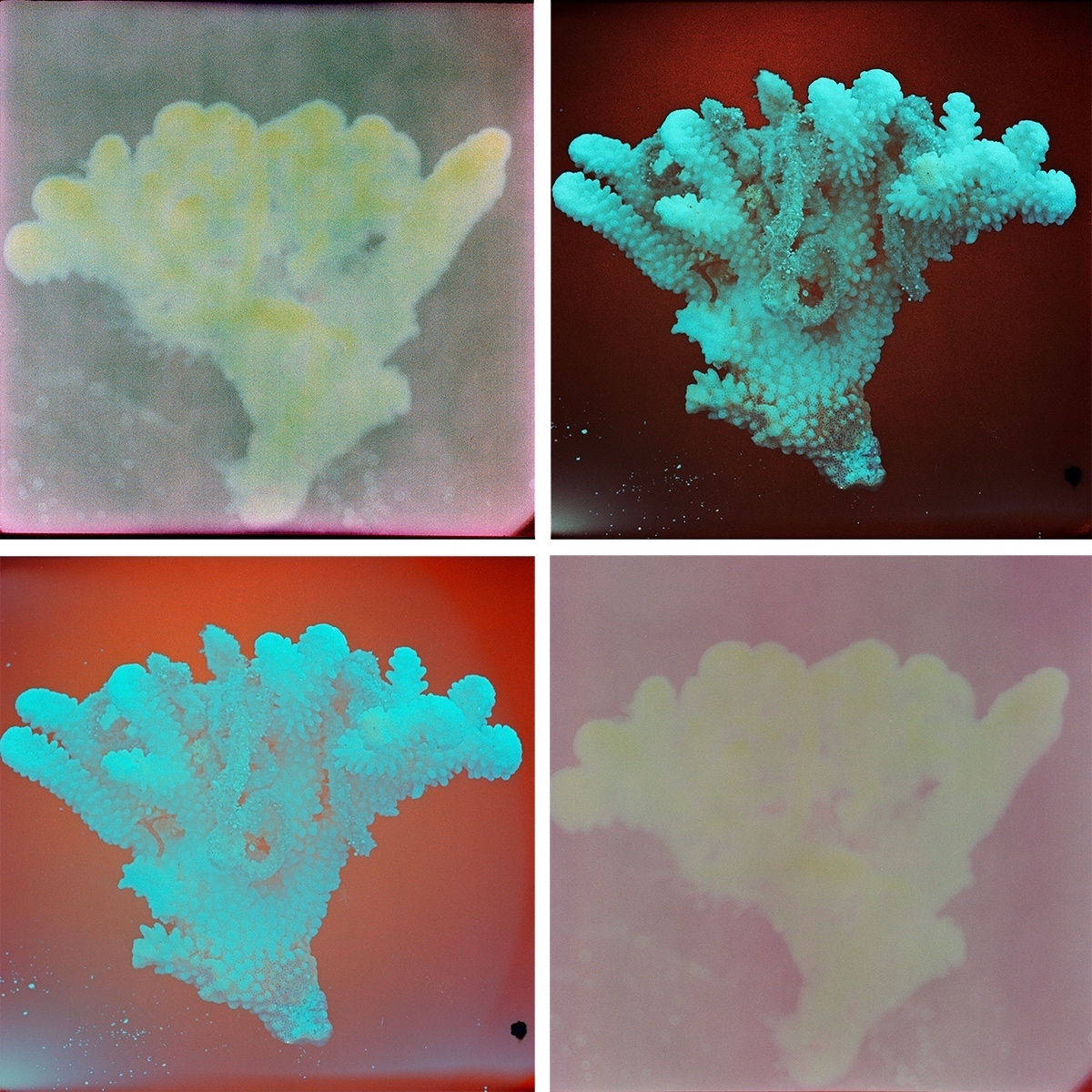
Entangled Rope With Coral (X4) Henderson Island, June 2019, from the series CROWN 2.5L, Photograph © Mandy Barker
Coral found entangled by rope, the most likely reason it has broken away from the reef surrounding Henderson Island, recovered by expedition leader Robin Shackell.
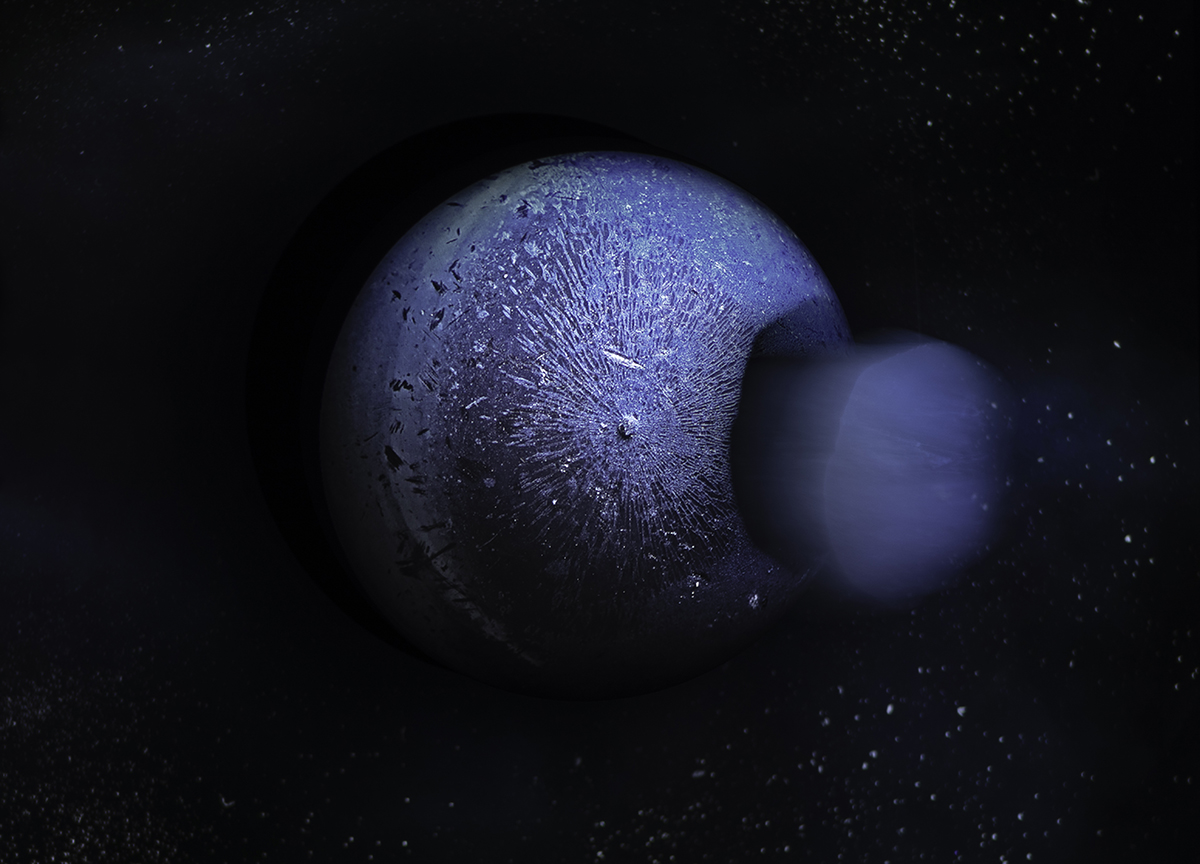
LUNASEA Eclipse No. 50 - UFO, from the series LUNASEA, Photograph © Mandy Barker
Moon eclipsed by (Unidentified Floating Object) recovered from Henderson Island, June 2019,
(Background includes; swirling sea of plastic pieces and coral dust from Henderson)
Some of your projects must have been very distressing and difficult to complete, as when you photographed the plastic debris in the Pacific Ocean from the Thoku earthquake and Japanese Tsunami, and when you joined scientists on Lord Howe Island to photograph birds unable to fly because of plastic in their stomachs.
Can you share with us about how you felt throughout and after, and the effects of plastic pollution you witnessed.
Ecological grief is feeling a sense of loss when working with environmental issues such as plastic pollution or climate change. Scientists I work with experience this and as you mention I have been affected in this way in the 2 situations you mention. In both cases the issue was so overwhelming that I did not take photographs for several days. Perhaps it was the fear of not being able to do the issue justice, or in the case of the Thoku earthquake and Japanese Tsunami, that the catastrophic devastation and lives lost were too distressing to link with the plastic pollution that resulted from this. Both projects were extremely difficult to make and I still have to make sure that especially ‘SHOAL’ which is the resulting series from Japan, is properly understood, exhibited and viewed in the right context.

31.15N, 155.22E , from the series SHOAL, Photograph © Mandy Barker
(Included with trawl: rescue workers helmets, glove, shoe sole, suitcase handle, flip flop, coat hanger, bath brush, kitchen cleaning containers, drinks crate, flower, tube with the words 'Tears in Cream').
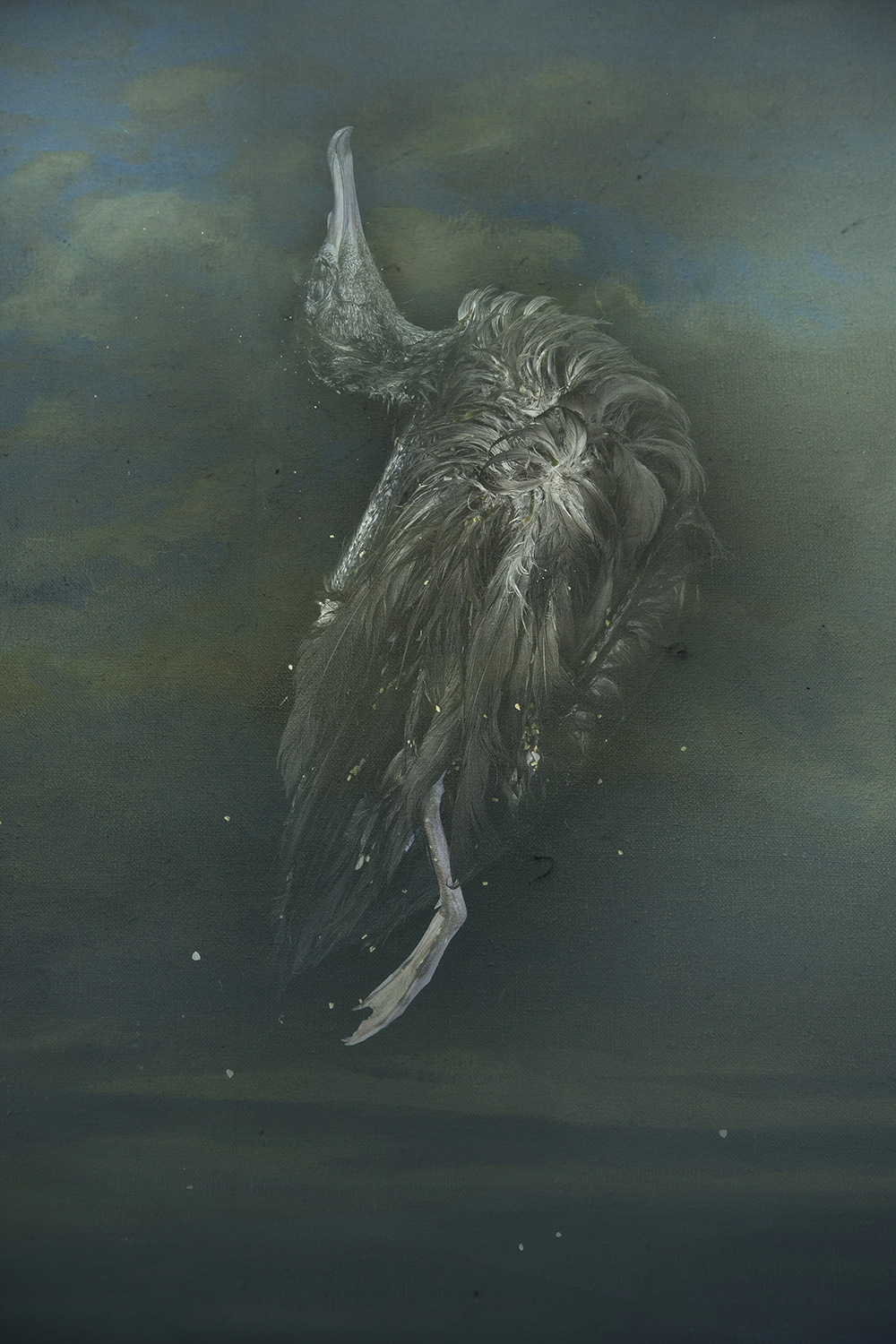
SKY - Flesh-Footed Shearwater, Photograph © Mandy Barker
Dignity in Death, after ingesting marine plastic pollution, Lord Howe Island, Australia
(with oil painting, Lord Howe Museum)
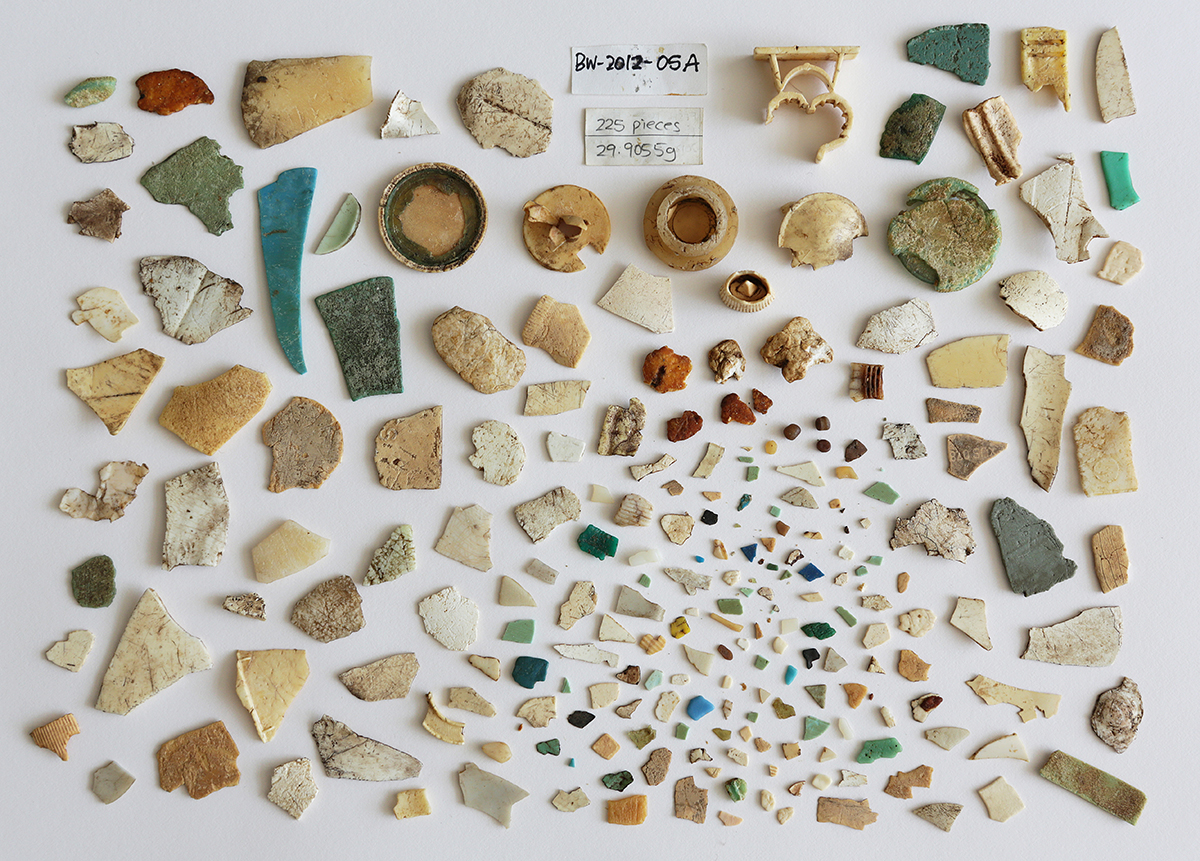
Plastic Pollution Removed From A Single Flesh-Footed Shearwater's Stomach, Photograph © Mandy Barker
(scientific sample, April 2012, Lord Howe Island)
You have collaborated with Stanford University on the launch of the virtual reality experience, ‘Ripple: the unintended life of plastics in the sea’, what are you thoughts on how technology, AI, could aid in finding solutions and raising further awareness of plastic pollution?
I am sure AI is going to have a huge impact on the world and how we access information, it is difficult to know how this will be managed, but if used in the right way in terms of accessing research could potentially be a very useful tool. But I believe AI will not be able to replicate the physical and emotional side of taking part in a research expedition on high seas, or picking up a recently deceased bird, still warm that has mistaken plastic for food and to then feel the plastic crunch within its stomach.

WE MUST ACT NOW
Smartie Lids, Photograph © Mandy Barker
Smartie sweet lids recovered from shorelines around the world after ceasing production over 14 years ago. Letters on the lids spell messages from the sea. Commission by WeTransfer - Union of Concerned Photographers UCP.
Mandy Barker is an international award-winning photographic artist whose work involving marine plastic debris for more than 13 years, has received global recognition.
Barker's work has been published in over 50 different countries including; National Geographic Magazine, TIME Magazine, The Guardian, The Financial Times, Smithsonian, The New Scientist, The Explorer's Journal, UNESCO, The British Journal of Photography, VOGUE, the World Wildlife Fund, and also to illustrate key academic and scientific research papers about current plastic research.
Her work has been exhibited world-wide from MoMA Museum of Modern Art, and the United Nations headquarters in New York, the Victoria & Albert Museum London, and the Science & Technology Park Hong Kong. Barker was shortlisted for the Prix Pictet Award SPACE 2017, the world's leading photography award for sustainability, and nominated for the Magnum Foundation Fund, LOBA Award, and the Deutsche Börse Foundation Photography Prize 2020. She is a recipient of the 2018 National Geographic Society Grant for Research and Exploration. Her first book 'Beyond Drifting: Imperfectly Known Animals' was selected as one of the Ten Best Photography Books of 2017, by Smithsonian, and ‘Altered Ocean’ was chosen by The Royal Photographic Society as one of the most coveted titles and top 10 Photobooks of 2019. Barker is a member of the Union of Concerned Photographers UCP, which is dedicated to using the power of imagery to underline the urgency of environmental concerns. In June 2019, invited by the UK Foreign and Commonwealth Office, Barker took part in the ‘Henderson Island Plastic Pollution Expedition’ which was awarded the title of an ‘Explorers Club Flag Expedition’.
In 2012 she was awarded The Royal Photographic Society's Environmental Bursary enabling her to join scientists in a research expedition which sailed from Japan to Hawaii to examine the accumulation of marine plastic debris in the tsunami debris field in the Pacific Ocean. In June 2017 she was invited by Greenpeace to join the Beluga II Expedition which sailed around the remote and unique island locations of the Inner Hebrides, Scotland, to recover plastic debris in a commission for Greenpeace. She has been invited as a guest speaker at the National Geographic Photography Seminar 2018 Washington DC, Stanford University California, for the British Council, and on behalf of the British Embassy at the political festival Almedalen in Sweden, also as the opening keynote speaker for the EuroConference GlobalCapital Sustainable & Responsible Capital Markets Forum in Amsterdam, and on the panel for the Opening Session for EU Greenweek 2021 in Brussels with Ursula von der Leyen, President of the European Commission. Throughout the COP26 Climate Change Conference 2021 hosted in the UK, Barker’s images were screened in a short film made about her working process by First Move Productions, and presented by the British Council in the Pavilion, Glasgow. She also presented her work in 17 different countries during COP26 to engage the world with this critical climate change issue. In 2019 Barker collaborated with Stanford University on the launch of the virtual reality experience, ‘Ripple: the unintended life of plastics in the sea’.
She has been committed to teaching workshops around the world for many years, with local communities, schools, and universities, from the Philippines to the Solomon Islands on behalf of the British High Commission, and with individual initiatives for ‘World Oceans Day’. She was part of a youth mentoring programme with First Exposures, an organisation that empowers youth through photography in San Francisco and freely gives her time to mentor others.
For more information on the artist's work and about plastic pollution see: https://www.mandy-barker.com
Instagram @mandybarkerphotography
Facebook https://www.facebook.com/MandyBarkerPhotography/
Twitter @plasticpieces
All images courtesy and copyright of Mandy Barker. No images to be shared, copied or kept.
Photograph © Mandy Barker
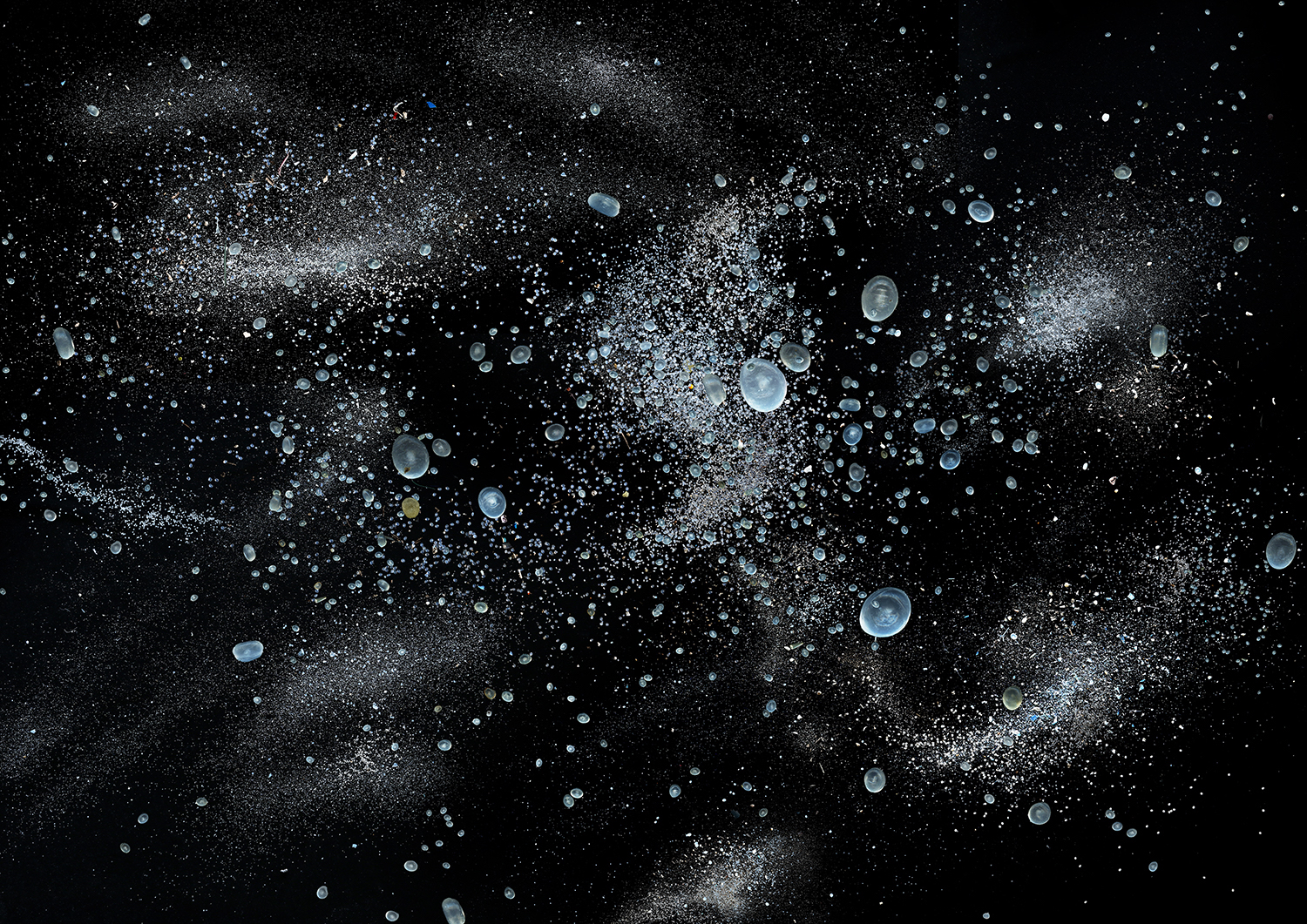
Hong Kong Soup: 1826 - Spilt, 香港湯:1826, Photograph © Mandy Barker
150 tonnes of pre-production plastic pellets (nurdles) spilt from a cargo container during Typhoon Vicente on 23 July 2012 adds to Hong Kong's waste issues in the sea and on its beaches. The image mirrors the night sky on the day of the spillage & includes nurdles recovered from six of the worst affected beaches.
